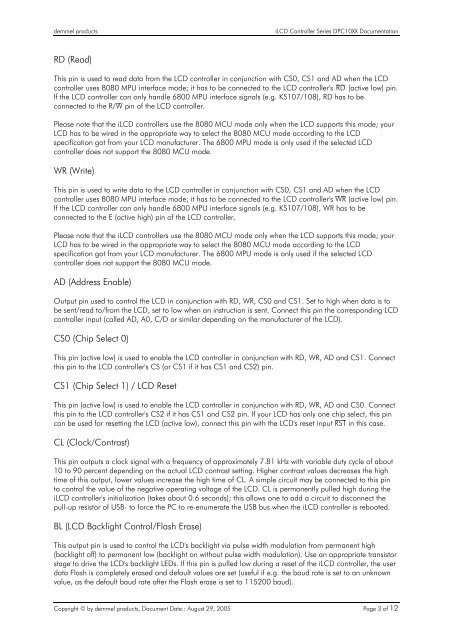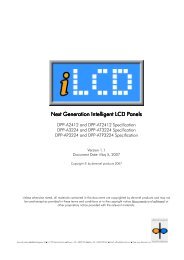iLCD Controller DPC10XX Series Documentation
iLCD Controller DPC10XX Series Documentation
iLCD Controller DPC10XX Series Documentation
Create successful ePaper yourself
Turn your PDF publications into a flip-book with our unique Google optimized e-Paper software.
demmel products <strong>iLCD</strong> <strong>Controller</strong> <strong>Series</strong> <strong>DPC10XX</strong> <strong>Documentation</strong><br />
RD (Read)<br />
This pin is used to read data from the LCD controller in conjunction with CS0, CS1 and AD when the LCD<br />
controller uses 8080 MPU interface mode; it has to be connected to the LCD controller's ¯¯ RD (active low) pin.<br />
If the LCD controller can only handle 6800 MPU interface signals (e.g. KS107/108), RD has to be<br />
connected to the R/W¯ pin of the LCD controller.<br />
Please note that the <strong>iLCD</strong> controllers use the 8080 MCU mode only when the LCD supports this mode; your<br />
LCD has to be wired in the appropriate way to select the 8080 MCU mode according to the LCD<br />
specification got from your LCD manufacturer. The 6800 MPU mode is only used if the selected LCD<br />
controller does not support the 8080 MCU mode.<br />
WR (Write)<br />
This pin is used to write data to the LCD controller in conjunction with CS0, CS1 and AD when the LCD<br />
controller uses 8080 MPU interface mode; it has to be connected to the LCD controller's WR ¯¯ (active low) pin.<br />
If the LCD controller can only handle 6800 MPU interface signals (e.g. KS107/108), WR has to be<br />
connected to the E (active high) pin of the LCD controller.<br />
Please note that the <strong>iLCD</strong> controllers use the 8080 MCU mode only when the LCD supports this mode; your<br />
LCD has to be wired in the appropriate way to select the 8080 MCU mode according to the LCD<br />
specification got from your LCD manufacturer. The 6800 MPU mode is only used if the selected LCD<br />
controller does not support the 8080 MCU mode.<br />
AD (Address Enable)<br />
Output pin used to control the LCD in conjunction with RD, WR, CS0 and CS1. Set to high when data is to<br />
be sent/read to/from the LCD, set to low when an instruction is sent. Connect this pin the corresponding LCD<br />
controller input (called AD, A0, C/D or similar depending on the manufacturer of the LCD).<br />
CS0 (Chip Select 0)<br />
This pin (active low) is used to enable the LCD controller in conjunction with RD, WR, AD and CS1. Connect<br />
this pin to the LCD controller's CS (or CS1 if it has CS1 and CS2) pin.<br />
CS1 (Chip Select 1) / LCD Reset<br />
This pin (active low) is used to enable the LCD controller in conjunction with RD, WR, AD and CS0. Connect<br />
this pin to the LCD controller's CS2 if it has CS1 and CS2 pin. If your LCD has only one chip select, this pin<br />
can be used for resetting the LCD (active low), connect this pin with the LCD's reset input RST ¯¯ in this case.<br />
CL (Clock/Contrast)<br />
This pin outputs a clock signal with a frequency of approximately 7.81 kHz with variable duty cycle of about<br />
10 to 90 percent depending on the actual LCD contrast setting. Higher contrast values decreases the high<br />
time of this output, lower values increase the high time of CL. A simple circuit may be connected to this pin<br />
to control the value of the negative operating voltage of the LCD. CL is permanently pulled high during the<br />
<strong>iLCD</strong> controller's initialization (takes about 0.6 seconds); this allows one to add a circuit to disconnect the<br />
pull-up resistor of USB- to force the PC to re-enumerate the USB bus when the <strong>iLCD</strong> controller is rebooted.<br />
BL (LCD Backlight Control/Flash Erase)<br />
This output pin is used to control the LCD's backlight via pulse width modulation from permanent high<br />
(backlight off) to permanent low (backlight on without pulse width modulation). Use an appropriate transistor<br />
stage to drive the LCD's backlight LEDs. If this pin is pulled low during a reset of the <strong>iLCD</strong> controller, the user<br />
data Flash is completely erased and default values are set (useful if e.g. the baud rate is set to an unknown<br />
value, as the default baud rate after the Flash erase is set to 115200 baud).<br />
Copyright © by demmel products, Document Date:: August 29, 2005 Page 3 of 12



